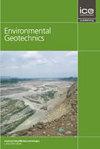电磁波对颗粒土水力导电性的影响
IF 2.2
4区 工程技术
Q3 ENGINEERING, GEOLOGICAL
引用次数: 0
摘要
电磁(EM)波,传统上用于诸如地球物理表征,要测量的冲击特性等目的。本文描述了射频(RF)波对玻璃微珠和天然砂的导电性的影响。在一个由有机玻璃制成的谐振腔内,使用一个定制的刚性壁圆柱形渗透率仪进行了一系列测试,该谐振腔由导电透明薄膜覆盖。采用恒水头ASTM-D2434试验测量样品的水力导率。使用磁耦合环路天线在不同频率和输入RF功率水平下进行射频刺激。在射频刺激下,天然砂和玻璃球样品的水力导电性均有所提高。此外,还进行了射频波的电场分量测量,以说明电场的模式,并评估射频对水力导电性测试的影响。对电场进行了数值模拟,并与实验测量的电场进行了验证。在MATLAB中建立了有限差分数值模型对渗流进行分析,并与实验结果进行了验证。然后使用优化方案建立RF对水力导电性影响的控制方程。本文章由计算机程序翻译,如有差异,请以英文原文为准。
Electromagnetic Waves’ Impact on Hydraulic Conductivity of Granular Soils
Electromagnetic (EM) waves, traditionally used for purposes such as geophysical characterization, impact properties to be measured. This paper describes the effects of radio frequency (RF) waves on the hydraulic conductivity of glass beads and natural sand. A series of tests was conducted using a customized, rigid-wall, cylindrical permeameter inside a resonant cavity made of Plexiglas covered with electrically conductive transparent films. Constant-head ASTM-D2434 tests were performed to measure the samples’ hydraulic conductivity. RF stimulation was performed using a magnetically coupled loop antenna at various frequencies and input RF-power levels. The hydraulic conductivity of both natural sand and glass-bead samples increased with RF stimulation. Furthermore, the measurement of the electric field component of RF waves was also performed to illustrate the pattern of the electric field, as well as evaluate RF’s impact on the hydraulic conductivity tests. The electric field was numerically simulated and validated against experimentally measured electric fields. A finite-difference numerical model was developed in MATLAB to analyze the seepage flow, which was then validated against the experimental results. An optimization scheme was then used to develop a governing equation for RF’s impact on hydraulic conductivity.
求助全文
通过发布文献求助,成功后即可免费获取论文全文。
去求助
来源期刊

Environmental geotechnics
Environmental Science-Water Science and Technology
CiteScore
6.20
自引率
18.20%
发文量
53
期刊介绍:
In 21st century living, engineers and researchers need to deal with growing problems related to climate change, oil and water storage, handling, storage and disposal of toxic and hazardous wastes, remediation of contaminated sites, sustainable development and energy derived from the ground.
Environmental Geotechnics aims to disseminate knowledge and provides a fresh perspective regarding the basic concepts, theory, techniques and field applicability of innovative testing and analysis methodologies and engineering practices in geoenvironmental engineering.
The journal''s Editor in Chief is a Member of the Committee on Publication Ethics.
All relevant papers are carefully considered, vetted by a distinguished team of international experts and rapidly published. Full research papers, short communications and comprehensive review articles are published under the following broad subject categories:
geochemistry and geohydrology,
soil and rock physics, biological processes in soil, soil-atmosphere interaction,
electrical, electromagnetic and thermal characteristics of porous media,
waste management, utilization of wastes, multiphase science, landslide wasting,
soil and water conservation,
sensor development and applications,
the impact of climatic changes on geoenvironmental, geothermal/ground-source energy, carbon sequestration, oil and gas extraction techniques,
uncertainty, reliability and risk, monitoring and forensic geotechnics.
 求助内容:
求助内容: 应助结果提醒方式:
应助结果提醒方式:


